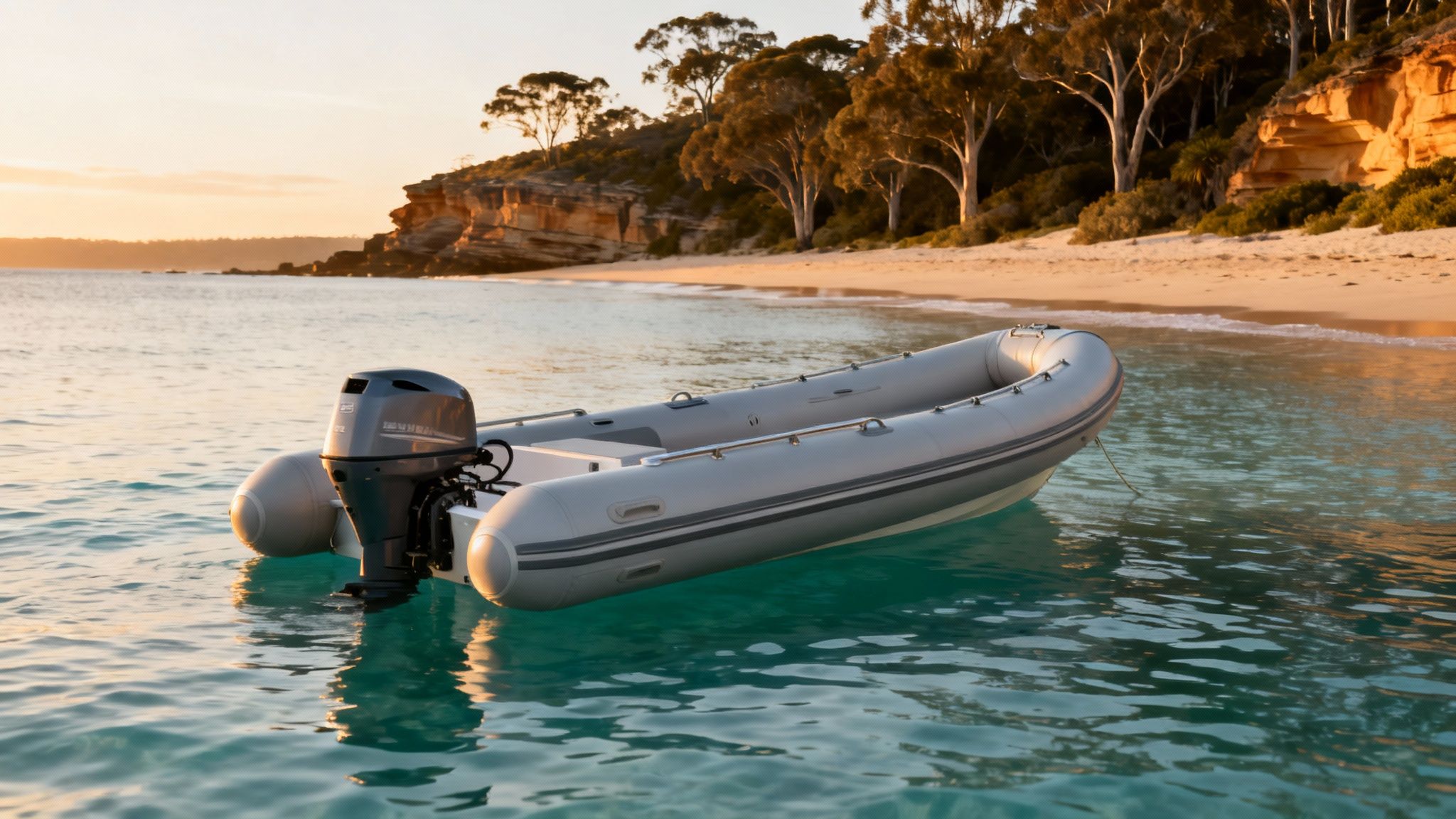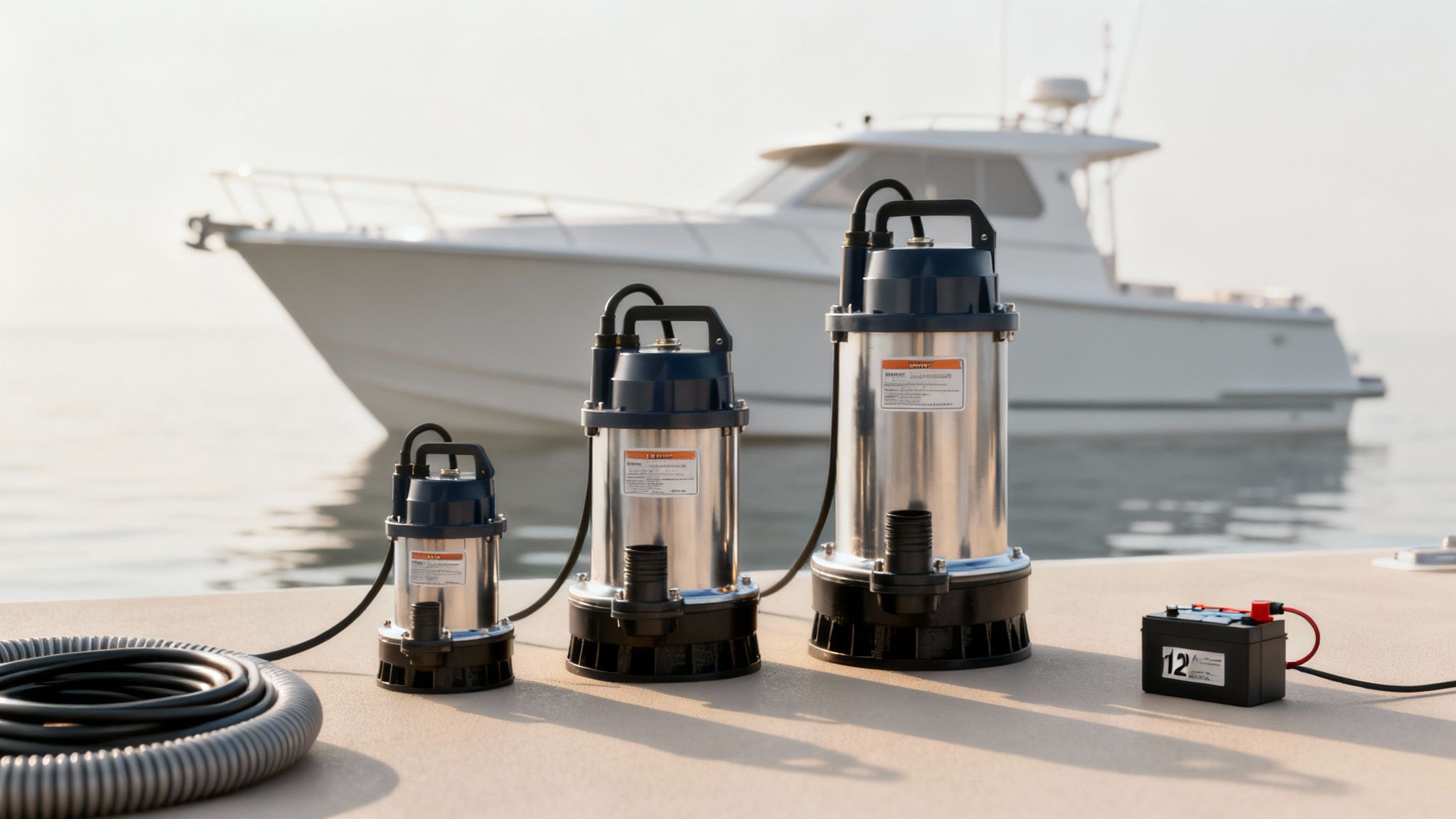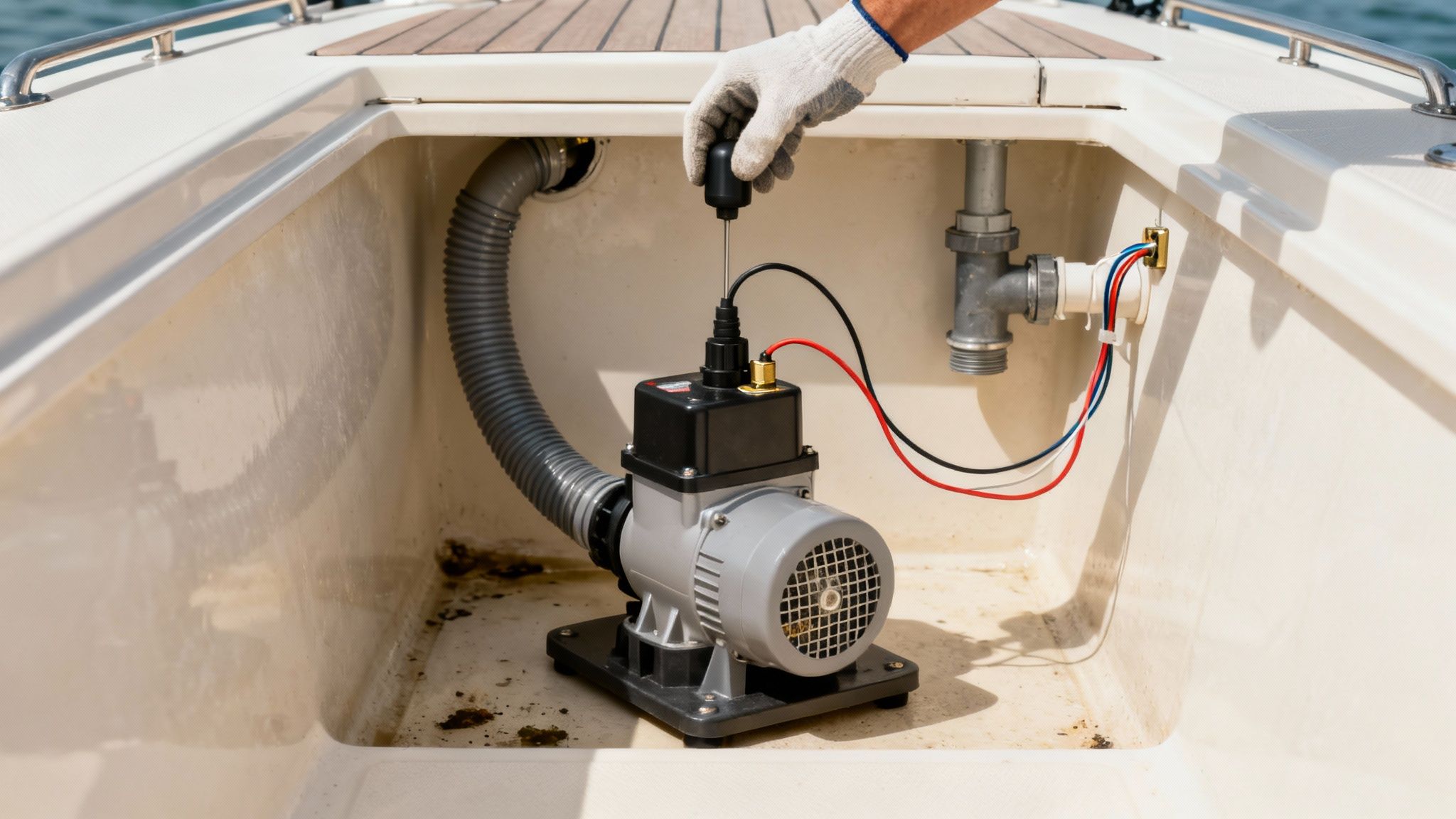
An automatic bilge pump is one of those critical bits of safety gear you hope you never need, but you'll be glad you have. It’s designed to automatically get rid of unwanted water from the lowest point of your boat—the bilge. Think of it as a silent guardian, protecting your vessel from rain, spray, or small leaks, even when you're not on board.
An automatic bilge pump is the ultimate safety net for your boat. Its job is simple but profoundly important: to remove the water that inevitably finds its way into the bilge. Without one, even a small amount from a passing shower or a tiny leak through a fitting can slowly build up, eventually threatening your boat's stability and safety.
The "automatic" part is what makes all the difference. Just like a sump pump protects a home’s basement from flooding, this device works on its own. It senses when water levels are rising and kicks into action to pump the water overboard. This 24/7 vigilance gives you incredible peace of mind, especially when your boat is moored and you’re not around. In the unpredictable waters around Australia, conditions can change in a heartbeat, and knowing your boat is protected from gradual water ingress is invaluable. For those looking to compare prices and features of automatic bilge pumps in your area, you have several options, from local marine chandleries to online retailers.
An automatic bilge pump is much more than a convenience; it's a non-negotiable part of modern boating safety. The key advantages are clear:
A reliable automatic bilge pump is a non-negotiable part of a comprehensive safety system. It's the first line of defence against the most common cause of sinking at the dock—unmanaged water accumulation.
Ultimately, installing an automatic bilge pump is a proactive step towards responsible boat ownership. It works alongside other essential safety gear. For more on being prepared for emergencies, you might want to check out our guide on choosing an ACR rescue beacon.
At its heart, an automatic bilge pump is a beautifully simple system. It’s all about three key parts working together in perfect harmony: the pump unit itself, a powerful electric motor, and the all-important automatic switch. This trio stands guard in the lowest part of your boat, ready to spring into action the moment it's needed.
The whole process is a straightforward cycle of detection and removal.
As water from rain, spray, or a small leak finds its way into the bilge, the level slowly rises. Once it hits a preset height, it triggers the switch. In an instant, the motor fires up, driving the pump to suck water from the bilge and shoot it safely overboard through a discharge hose. This continues until the water level drops back down, deactivating the switch and putting the pump back on standby.
This visual breaks down that simple yet critical process.

As you can see, it's a three-stage operation that responds automatically to keep your boat dry and safe, without you having to do a thing.
The real "magic" behind the whole setup is the automatic switch—it’s the brain of the operation. While there are a few different types out there, the most common one you'll find is the float switch. The best way to picture how it works is to think of the float mechanism inside the tank of your toilet at home.
A buoyant float is connected to a small lever. As water in the bilge rises, it lifts the float. When it gets high enough, the lever flips a switch, closing an electrical circuit and sending power to the pump motor. It’s that simple.
The float switch is the unsung hero of the automatic bilge pump. Its simple mechanical design provides a reliable trigger, ensuring the pump only runs when necessary, thereby conserving battery power and preventing unnecessary wear.
Once the pump has cleared enough water, the level drops, the float lowers with it, and the switch opens the circuit, shutting the pump off. This reliable, low-tech solution is precisely why these systems are so dependable. For a deeper dive into these crucial components, you can learn more about the mechanics of the bilge pump float switch in our dedicated article. It's worth noting there are also electronic switches that use sensors to detect water, offering a modern alternative with no moving parts.
No matter the type of switch, the principle is the same: detect rising water, kick the pump into gear, and protect your boat. This simple automation is what gives boaters all across Australia invaluable peace of mind.

Picking out the right automatic bilge pump can feel a bit daunting, but it all boils down to one simple idea: match the pump to your boat. You wouldn’t try to empty a swimming pool with a bucket, and the same logic applies here. The single most important factor is the pump's capacity, which is measured in Gallons Per Hour (GPH).
This rating tells you exactly how much water the pump can shift in an hour, assuming perfect conditions. A small fishing tinnie has completely different needs to a big cruising yacht sailing offshore. One of the most common mistakes is picking an undersized pump, which can leave your boat dangerously exposed when you really need it to perform.
A great place to start is your boat's length. While it’s not a perfect science, it gives you a solid baseline for what you'll need. When in doubt, it’s always smarter to go for a more powerful pump than one that might struggle.
To help you get a handle on the minimum capacity your boat requires, here's a quick reference table.
| Boat Length (Metres) | Minimum Recommended GPH |
|---|---|
| Up to 5.5 metres | 500 GPH |
| 5.5 to 7.5 metres | 800 – 1,200 GPH |
| Over 7.5 metres | 2,000+ GPH |
Keep in mind these are just the minimums. If you often head offshore or find yourself boating in rough Australian weather, stepping up to the next size gives you a welcome extra layer of security.
While capacity is king, a few other things are just as critical for making the right choice. An automatic bilge pump is only as good as its weakest link, so it needs to fit your boat’s setup and be dependable when it counts.
An effective automatic bilge pump system is a sum of its parts. The right capacity, a reliable switch, and a correct fit for your bilge are all equally important for ensuring your boat stays afloat.
Before you make a final decision, think about these vital points:
Ultimately, the right automatic bilge pump is all about peace of mind. And for true failsafe protection, it’s always a good idea to have one of the many available manual bilge pumps stashed on board as a backup.
Upgrading to an automatic bilge pump is one of the smartest moves any boat owner can make. Its biggest advantage is the relentless, 24/7 protection it offers. Think of it as a silent guardian against sinking, whether your boat is sitting at its mooring during a heavy downpour or springs a slow leak while you're miles away.
This automated vigilance is what stops a minor issue from turning into a disaster. Imagine a small, unnoticed leak in a through-hull fitting. Over a few days or weeks, that tiny drip could slowly fill the bilge and put your whole vessel at risk. An automatic system catches that rising water level and pumps it out long before it becomes a real threat, protecting your pride and joy.
Beyond pure safety, a working automatic bilge pump is also about staying on the right side of the law. These systems have become a non-negotiable safety and environmental requirement in Australia, thanks to strict government regulations.
In fact, authorities now mandate that over 95% of commercial and recreational vessels in Australian waters must have a functioning automatic bilge pump system as core safety equipment. To get the full picture on these rules, you can explore detailed insights on the Australian automatic bilge pump market.
This regulatory backing isn't just red tape; it underscores how critical these systems are for keeping our waterways safer for everyone.
An automatic bilge pump delivers something truly priceless: peace of mind. Knowing your boat is actively protecting itself from water build-up around the clock lets you worry less and enjoy your time on the water more.
Ultimately, it all comes down to a powerful trio of protection, compliance, and confidence.
This triple-threat of benefits makes an automatic bilge pump an essential piece of kit for any responsible boat owner. It's a system that works tirelessly in the background to ensure your boat is safe, sound, and ready for your next adventure. This proactive defence is the key to preserving both your vessel and your enjoyment of it.
An automatic bilge pump is an incredibly reliable piece of equipment, but all that dependability hinges on two things: getting the installation right and giving it consistent care. Even the best pump in the world won't do you any good if it’s installed poorly or clogged with gunk when you need it most.
By following a few core principles, you can make sure your pump is always ready to act as your boat's silent guardian.
Proper installation starts with placement. The pump has to sit in the absolute lowest part of the bilge where water first collects, no exceptions. From there, the discharge hose needs to be routed correctly—ideally with a high loop—to stop seawater from siphoning back into your boat. Finally, a solid electrical connection is non-negotiable; for ultimate reliability, it should be wired directly to the battery with its own fuse.

Once it's installed, keeping your automatic bilge pump in top shape is pretty straightforward. This isn't about hours of work, just a few simple, regular checks. Making these habits part of your routine is the key to long-term reliability and peace of mind on the water.
This proactive approach has proven benefits. Regular maintenance cycles mandated by local regulations have also decreased bilge pump failure rates from an estimated 14% in 2010 to below 6% in recent years, demonstrating effectiveness in improving maritime safety. You can read the full research about bilge pump market trends to see how these practices make a difference.
Think of bilge pump maintenance like checking the oil in your car. It's a quick, simple task that prevents catastrophic failure down the road. A few minutes of prevention is worth more than hours of stressful repairs.
Here is a simple checklist to follow:
These simple routines are vital for any vessel, from a large yacht to a smaller craft. For those with inflatable boats, these checks are just one part of a complete upkeep routine, and you might be interested in our guide on inflatable boat maintenance made simple. By making these habits second nature, you ensure your automatic bilge pump is always ready to protect your investment.
If your pump is running non-stop, it’s usually telling you one of two things. The first and most common culprit is a jammed float switch. Bilge gunk and debris can easily get lodged under the switch, locking it in the "on" position and making the pump work overtime. If that's not the problem, it might be pointing to a more serious leak that the pump can't keep up with.
On the other hand, what if the pump won't switch on at all? Don't panic. The fix is often surprisingly simple. Always start with the basics: a clogged inlet strainer is the number one reason a pump stops working, as debris simply blocks water from getting in.
If the strainer is clear, your next stop is the power source. A dead battery or a blown fuse will obviously stop the pump in its tracks. You'll also want to give the wiring a good look-over. Loose connections or corrosion are classic issues in the harsh marine environment.
Here’s a quick checklist to run through when your pump refuses to start:
A bilge pump that won't work isn't just an annoyance; it's a critical safety failure. Being able to quickly figure out if it's a simple clog or a wiring fault is a fundamental skill for any boat owner.
This practical approach empowers you to handle the small stuff yourself. And for those bigger problems, knowing the cause helps you have a much more productive conversation with a marine technician. For more detailed guides, check out our articles on bilge pump repair. Mastering these troubleshooting steps makes you a more capable and self-reliant boatie.
When you're out on the water, having the right gear and knowledge makes all the difference. Here are some quick answers to common questions Aussie boaters ask about automatic bilge pumps, helping you stay safe and sort fact from fiction. If you're wondering what the best automatic bilge pumps for recreational use are available near you, local marine suppliers and online stores often stock leading brands suited for various boat sizes.
Yes, you absolutely do. Think of it as your ultimate backup plan. Australian maritime rules often demand a manual pump on board, and for good reason. Your automatic pump runs on battery power, and if that fails—or the wiring gets fried—you're left with no way to get water out.
A manual pump is your failsafe. It’s a crucial piece of safety gear that ensures you can always deal with water in the bilge, no matter what happens with your electronics. If you need to hire a boat for a family outing in Australia, you can find local operators who provide vessels equipped with all the necessary safety gear, including both automatic and manual pumps.
The best habit you can get into is testing it before every single trip. It only takes a second—just lift the float switch manually and listen for that reassuring whir of the pump kicking in. Simple.
On top of that, give it a more thorough check once a month as part of your regular maintenance. That means clearing out the strainer, checking the wiring for any corrosion, and making sure the whole area is free of gunk.
Consistent testing is the cheapest insurance you can get. That five-second check at the dock could prevent a catastrophic failure when you’re miles from shore.
It definitely can, which is why a proper setup and a bit of maintenance are so important. If you’ve got a serious leak or the float switch gets jammed in the "on" position by some stray debris, that pump will run and run until your battery is completely flat.
This is exactly why you need to:
For reliable, high-performance inflatable boats and all the essential gear to keep you safe on Australian waters, trust Easy Inflatables. Check out our full range of boats and accessories at https://easyinflatables.com.au.
Experience the ultimate freedom on the water with our top-quality inflatable boats and accessories. Easy Inflatables is your trusted partner, providing everything you need for a safe and unforgettable adventure.
At Easy Inflatables, we believe in empowering adventurers with high-quality inflatable solutions. Our commitment to durability and performance ensures that every product enhances your outdoor experiences.